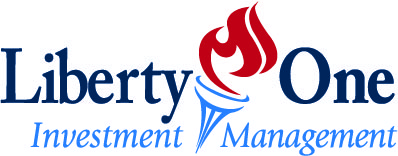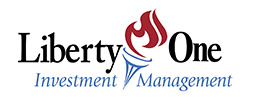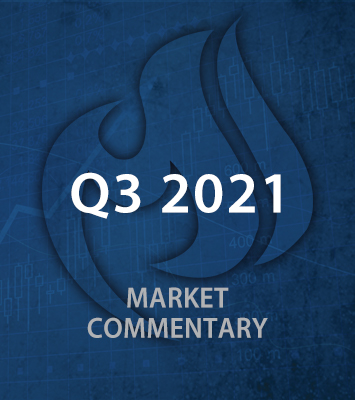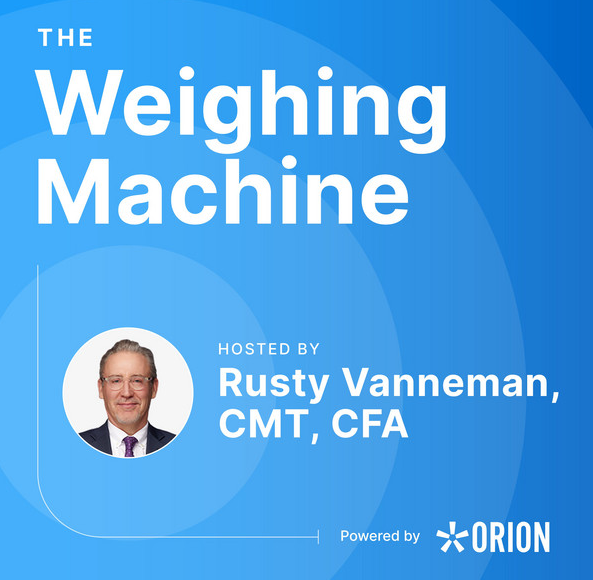Equities and risk assets experienced heightened volatility in the third quarter but managed to log yet another positive return of +0.58% for the quarter. Strong earnings results, a dovish Federal Reserve, and a strong US consumer base were large positives for the markets. On the flip side, debt ceiling concerns, intra-party disagreements over Democratic priorities, slowing economic growth, an overly leveraged Chinese real estate market, and inflation worries caused some jitters in financial markets.
Strong earnings results were heavily supported by consumers ongoing willingness to spend despite inflationary pressures. In aggregate, US consumers are coming out of the pandemic with a much healthier balance sheet and record net worth. A surging real estate and stock market coupled with fiscal stimulus support created an unprecedented increase in wealth for US households and non-profit organizations. In the last 12 months ending June 2021, total household and non-profit organizations added $23 trillion to their total net worth, a 19.55% increase. Comparatively, total net worth increased by $20 trillion between 2016 to 2020, a 21.78% increase.
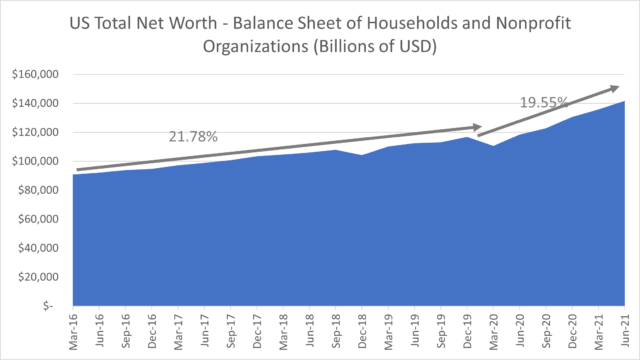
Simply put, households and non-profit organizations added more wealth in the last 12 months than they did in the preceding 5 years. Such positive wealth creation translated into higher consumption, leading to heightened demand, and adding additional pressures on global supply capacity. To illustrate the strength of the US consumers, year over year change in retail sales data have increased by more than 10% every month this year, recording one of the best stretches for retail sales data in history. Existing levels are far exceeding 2019 levels when the economy was at full employment with a well-functioning supply chain.
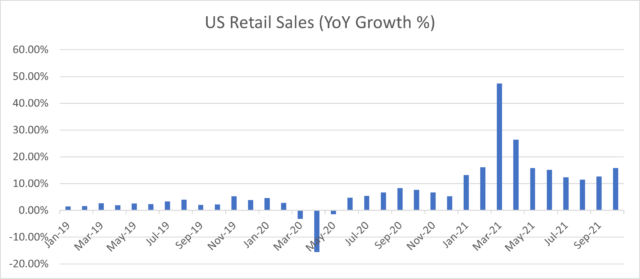
As consumer demand remained resilient, businesses experienced difficult times with restocking its inventories in an already stretched and fragile global supply chain due to covid disruptions. Although the US ISM Inventories Index came in at 55.6 in September 2021, indicating an expansionary environment for nominal inventories, the Business Inventory to Sales Ratio declined to 1.26x, below its long-term average of 1.40x. This is an indication that sales are currently outpacing restocking efforts, a positive development for many businesses that is translating into stronger earnings results. Despite this stronger environment, businesses are warning of margin pressures in future quarters as higher consumption are exerting strains on supply capacities, creating an upward pressure on price inflation. Should companies pass on higher prices to consumers, the sustainability of heightened consumer demand may become a concern as consumers could potentially scale back on their purchases. However, early indications do not suggest that this is happening, and consumers continue to spend despite recent price increases.
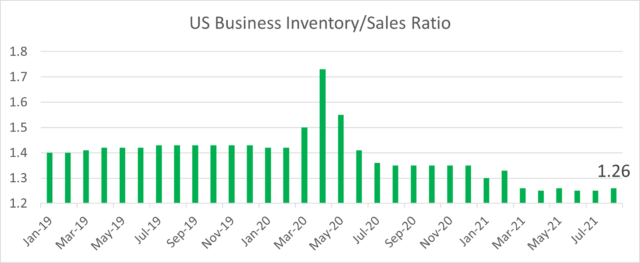
Rising prices are a function of rising input cost inflation for many companies. For service-based businesses, it is wage growth inflation that are primary costs for margin pressures. Aggregate wage growth increased 4.51% year over year, but the largest increases are occurring in industries that were most affected by the COVID lockdowns like leisure, hospitality, retail, and education. There are still close to a million less workers within these industries post-COVID relative to pre-COVID which are causing labor shortages and increased wage pressures. Health concerns, additional family responsibilities, better job opportunities elsewhere, and discouraged workers are among factors contributing to these shortages. In contrast, the IT sector which typically leads all industries in wage growth is experiencing the least wage growth pressures in 2021. This could partly be explained by the fact that the Information sector was least economically affected by the COVID pandemic.
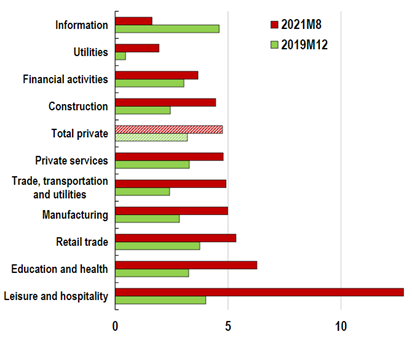
For product-based businesses, shipping and commodities costs are exerting pressures on input costs. Shipping container costs from Asia to North America have increased by fivefold since last year despite efforts by global shipping competition agencies and commitments by some carriers to freeze rates. Rates for a 40-foot container are going for over $20,000 today when it was $4,500 this time last year. Increased demand for consumer products like electronics, appliances, and automobiles that are usually produced in Asia spiked during the pandemic and continued to increase as economies re-opened after lockdown measures were lifted. This surge in demand resulted in higher shipping rates for containers coming out of Asia. Additionally, a combination of labor shortages, congestions, vessel delays, and equipment shortages have compounded underutilization of container capacity which are also causing disruptions and upward pressures on shipping rates. Rates are likely going to remain high so long as consumer demand for goods remain robust. With peak Christmas season coming up in the US, we do not expect high shipping rates to come down anytime soon.
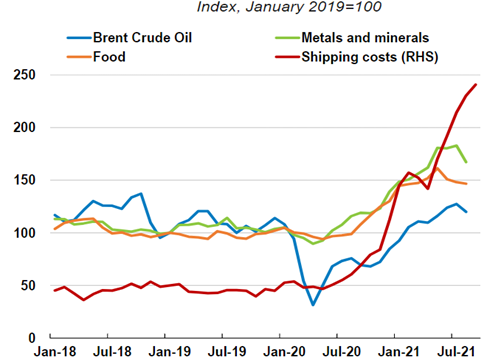
With oil prices up 80% year-to-date, a wide variety of products ranging from plastics to fertilizers have been affected by rising costs. After experiencing severe disruptions at the height of the pandemic, with negative prices at one point, oil markets are now experiencing prices not seen since the fracking boom in the mid 2010’s. A large contributor to higher oil prices have been a combination of increased demand and limited supply as economies re-opened while oil production remained below pre-COVID levels. For example, new US oil rig count is currently a little over half of what it was at the end of 2019.
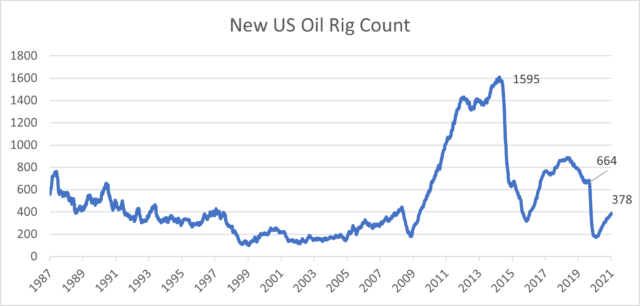
Furthermore, the focus on renewable energy and investors’ aversion to the fossil fuel industry is causing some of the oil majors to cut back on their capital spending and instead, opting to use their strong cash flow to buy back shares and pay out dividends to lure back investor interests.
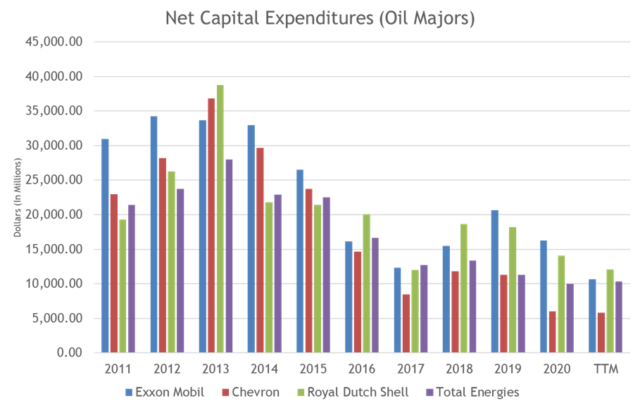
With the lack of substantially higher oil production in the near-term, we expect oil prices to remain above its 3-year historical average. This will likely induce a more persistent inflation outlook and one that bears monitoring.
Financial Markets
Despite a volatile end to the quarter, the S&P 500 continues to surprise to the upside. With the outperformance of some of the largest companies in the index, the top 10 stocks now make up close to 30% of the index, its highest concentration level since the dot-com bubble. Additionally, valuations of the biggest companies are also at above average levels relative to the rest of the index.
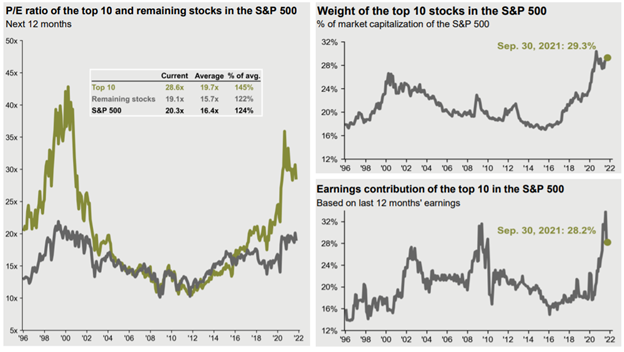
Although one can challenge the justification of market valuations for some of these large companies and the position size they hold in the index, when we look at the earnings contribution of these top 10 stocks, one can understand why they command such large weight in the benchmark. The size and quality of earnings produced are significant, with the top 10 stocks producing approximately 28% of the benchmark’s earnings. The consistency and earnings quality can also help explain the higher valuation multiples placed on these same stocks, with the current price to earnings ratio of the top 10 stocks measuring at 28.6x versus 19.1x for the remaining of the S&P 500 stocks.
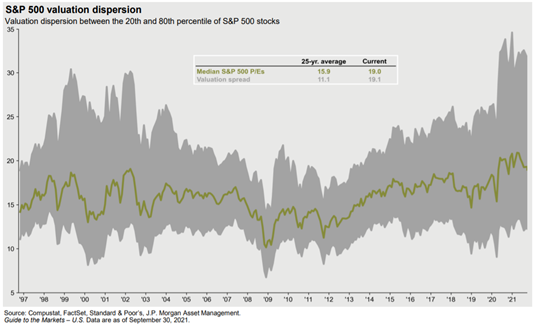
Markets may look strong in aggregate, but that there are some challenges beneath the surface. Valuation dispersion between stocks in the index today are almost twice as large as its 25-year average. The valuation spread between the 20th and 80th percentiles of stocks in the index is currently 19.1 points vs its 25-year average of 11.1. This large spread creates an environment conducive for active managers to highlight their stock selection abilities should that higher dispersion remain prominent as deviations from benchmark weightings may create a more material impact for active portfolios.
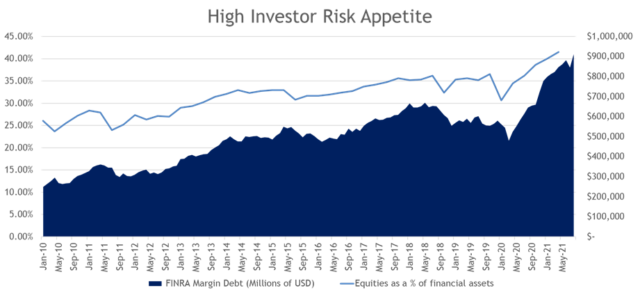
Investor risk appetite remain high as markets continue their upward ascend. Margin debt at the end of the quarter stood close to $1 trillion, up 39% over the last 12 months which although seems a lot, is much slower than prior market peaks when margin debt increased 56% in 1972, 59% in 1999, and 68% in 2007. Although the absolute level of margin debt is at an all-time high, growth of that debt is slower and appears more important in identifying potential changes in investor risk sentiment.
Looking Ahead
Looking ahead, there are reasons to be cautious on general market indices. Although the S&P 500 is within 4% of its 52-week high, 71% of the S&P 500 members have had corrections of more than 10% while 29% of them have had corrections of more than 20%. The small-cap Russell 2000 index does not fare much better, with 88% of its members seeing declines of more than 10% from its 52-week high, while 70% have declined by more than 20%. Additionally, the ongoing energy crisis in Europe and Asia could also cause economic shocks to an already fragile system flushed inflationary pressures and ample liquidity. Finally, the Federal Reserve is also hinting at plans on taking its foot off the gas, potentially negatively affecting return expectations.
On a positive note, stronger bipartisanship on key economic initiatives such as the Infrastructure Bill and further fiscal stimulus could keep supporting the economy, although it could hurt the value of US Treasuries. An extension of the debt ceiling and further fiscal negotiations could also mitigate investor anxiety that were dominant towards the end of this quarter.
